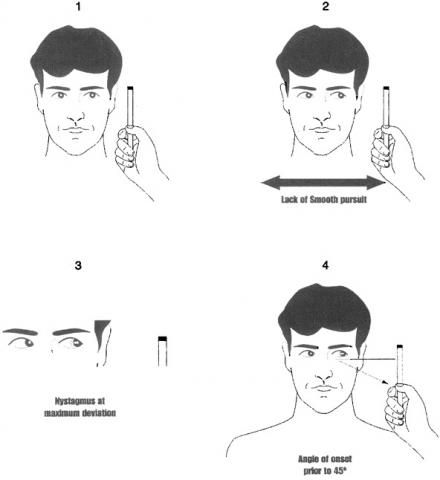Milwaukee230 West Wells Street - Suite 706 Tel - 414.207.4426 |
Madison403 Venture Court - Suite 2 Tel - 608.320.6710 |
Field Sobriety Tests are Unreliable
 FIELD SOBRIETY TESTS (FSTS) Anytime an OWI stop is made, the arresting officer will try to administer field sobriety tests. There are only three recognized field sobriety tests: These include 1) Horizontal Gaze Nystagmus 2) Walk and turn 3) One leg stand. These tests are not always accurate and a good Wisconsin OWI lawyer can discredit or limit them.
FIELD SOBRIETY TESTS (FSTS) Anytime an OWI stop is made, the arresting officer will try to administer field sobriety tests. There are only three recognized field sobriety tests: These include 1) Horizontal Gaze Nystagmus 2) Walk and turn 3) One leg stand. These tests are not always accurate and a good Wisconsin OWI lawyer can discredit or limit them.
The horizontal gaze nystagmus (follow my pen/finger with your eyes) is often not performed properly by arresting officers. Moreover it is designed to test whether a subject is above .10 blood alcohol concentration and not .08. Last, according to the National Highway Traffic Safety Administration this test is only accurate to 77% (it is false positive for several reasons including medical disorders, caffeine, eye strain, nicotine, contacts etc.). For the above reasons and several others, an effective Wisconsin OWI lawyer can prove a driver was not under the influence regardless of the observations of the arresting officer regarding horizontal gaze nystagmus.
In the walk and turn test, the subject is directed to take nine steps, heel to toe, along a straight line. After taking the steps, the driver must turn on one foot and return in the same manner in the opposite direction. The examiner looks for seven indicators of impairment. If the driver cannot keep balance while listening to instructions, begins before the instructions are finished stops while walking to regain balance, does not touch heel to toe, uses arms to balance, loses balance while turning, or takes an incorrect number of steps, NHTSA research indicates that 68 percent of individuals who exhibit two or more indicators in the performance o the test will have a BAC of .10 or greater.
In the one-leg stand test, the suspect is instructed to stand with one foot approximately six inches off the ground and count aloud by thousands (one thousand one, one thousand two) until told to put the foot down. The officer times the subject for 30 seconds. The officer looks for four indicators of impairment: including swaying while balancing, using arms to balance, hopping to maintain balance, and putting the foot down. NHTSA research indicates that 65 percent of individuals who exhibit two or more such indicators in the performance of the test will have a BAC of .10 or greater.
Other Field Sobriety Tests: It is very common for officers to provide other non-standardized field sobriety tests to drivers. This creates several problems, the most concerning being that it is a subjective test designed for the driver to fail.
HORIZONTAL GAZE NYSTAGMUS LEFT RIGHT Equal Pupils 9 Yes 9 No k LACK OF SMOOTH PURSUIT Equal Tracking 9 Yes 9 No k DISTINCT AND SUSTAINED NYSTAGMUS AT MAXIMUM DEVIATION Vertical Nystagmus 9 Yes 9 No k ONSET OF NYSTAGMUS PRIOR TO 45 DEGREES Other (i.e., Resting Nystagmus)_____________________________________________________ PBT (1) (optional) Time:__________ Results:__________ PBT (2) (optional) Time:__________ Results:__________ WALK AND TURN INSTRUCTIONS STAGE CANNOT KEEP BALANCE STARTS TOO SOON WALKING STAGE FIRST NINE STEPS SECOND NINE STEPS STOPS WALKING MISSES HEEL -TO- TOE STEPS OFF LINE RAISES ARMS ACTUAL STEPS TAKEN IMPROPER TURN (Describe) _________________________________________________________________________ CANNOT DO TEST (EXPLAIN) ________________________________________________________________________ _________________________________________________________________________________________________ OTHER: __________________________________________________________________________________________ ONE LEG STAND L R Sways while balancing. Uses arms to balance. Hopping. Puts foot down. CANNOT DO TEST (EXPLAIN) ___________________________________________________________________________ _____________________________________________________________________________________________________ OTHER: __________________________________________________________________________________________
